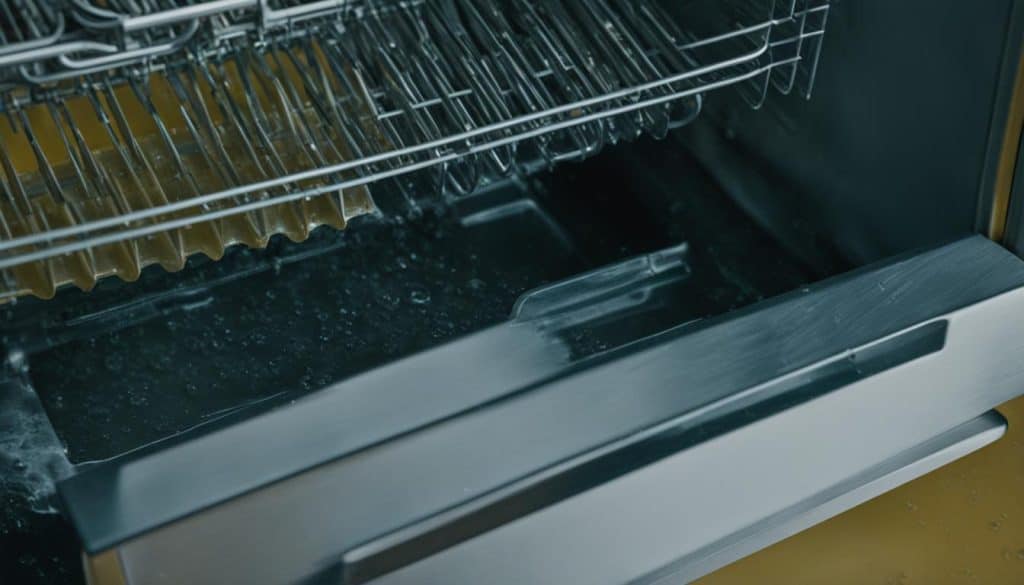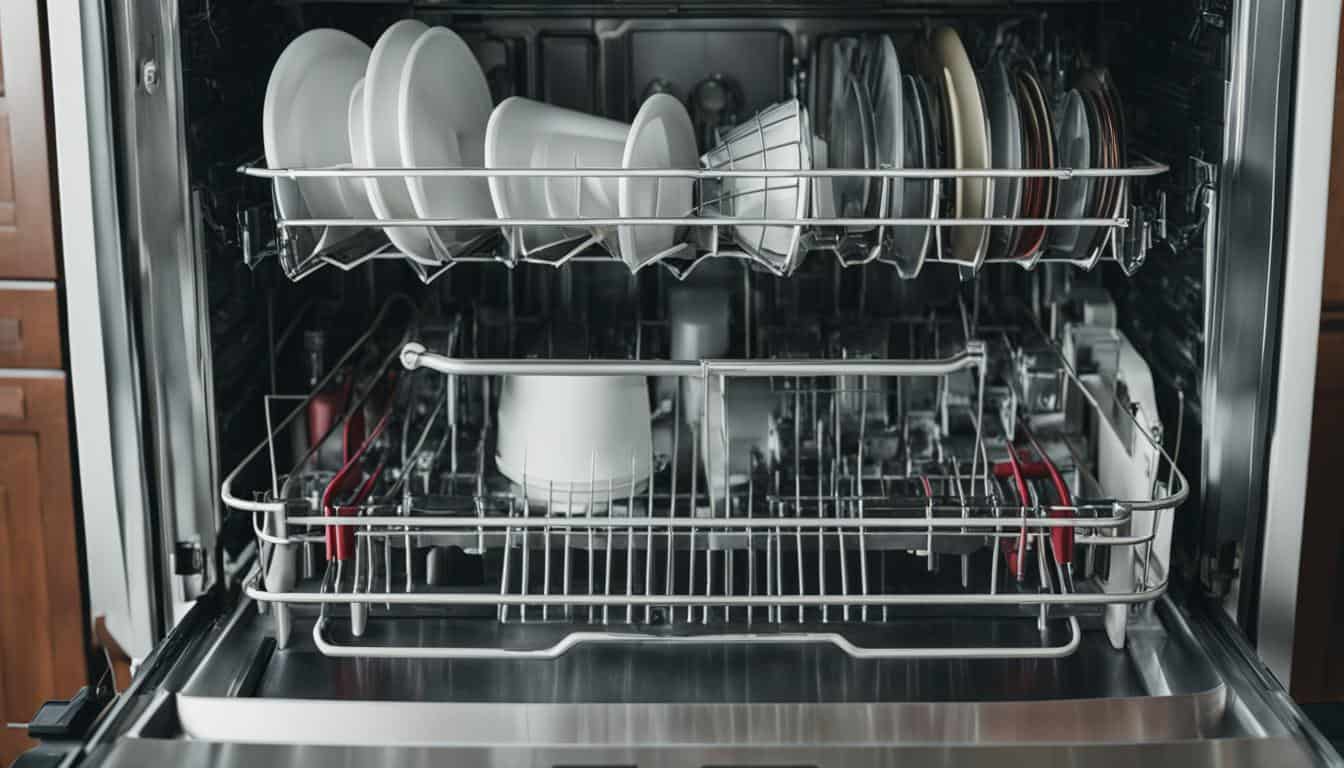Let’s chat about Diagnosing Common Dishwasher Problems. You know, it’s like being a detective in your own kitchen! Imagine your dishwasher starts acting up, maybe it’s leaking water or making strange noises, and you’re like, “What’s going on here?” It’s super important to figure out these little mysteries before they turn into big headaches.
So, first things first, we need to check for Water Leaks and Drainage Issues. Picture this: You’re all set to relax after dinner, but instead, you find a puddle of water near your dishwasher. Yikes!
And then there’s the case of the Dirty Dishes – you open the dishwasher expecting sparkly clean dishes, but they’re still dirty. Not cool, right? Plus, when it starts sounding like a spaceship with all those Unusual Noises, you know something’s up.
Now, don’t forget those mysterious Error Codes. They’re like secret messages your dishwasher is trying to tell you. And if the Door Latch won’t close, it’s like your dishwasher is saying, “Nope, I’m not working today!”
Also, check if the Electrical Issues are playing the villain, or maybe the Detergent Dispenser is just being stubborn. Oh, and the Water Temperature and Filter Maintenance are super important too.
They’re like the hidden heroes making sure your dishes are squeaky clean. So, let’s put on our detective hats and solve these dishwasher mysteries together!
1. Dishes Aren’t Getting Clean
There’s nothing more frustrating than hand-washing dishes after they’ve gone t ough a dishwasher cycle. If you’re experiencing this, it could be due to various reasons including clogged spray arms, dirty filters, incorrect detergent placement, or overloading the dishwasher. Thankfully, there are solutions to help restore optimal cleaning performance.
Clogged Spray Arms
Your dishwasher’s spray arms are responsible for distributing water t oughout the tub to clean your dishes. However, when they become clogged with debris or mineral buildup, water flow is hindered, and your dishes won’t come out clean. To fix this issue:
- Remove the spray arms from the dishwasher. Consult your user manual if you’re unsure how to do this.
- Soak the spray arms in white vinegar or a descaling solution for at least an hour.
- Scrub the spray arms with a soft brush to remove any remaining debris.
- Rinse the spray arms thoroughly and reattach them to your dishwasher.
Dirty Filters
Your dishwasher’s filters are designed to trap food particles and debris during the washing cycle. If the filters become clogged, water won’t be able to circulate properly, and your dishes won’t be cleaned thoroughly. To clean your filters:
- Remove the filters from your dishwasher. Refer to the user manual if necessary.
- Rinse the filters under hot water to remove any debris and buildup.
- If the filters are heavily soiled, soak them in hot, soapy water for at least 15 minutes.
- Rinse the filters with water and reinsert them into your dishwasher.
Incorrect Detergent Placement
Using the wrong type of detergent or placing it incorrectly can lead to poor cleaning performance. Make sure you’re using the detergent recommended by your dishwasher’s manufacturer and that you’re putting it in the correct compartment. Consult your user manual if you’re unsure.
Overloading the Dishwasher
When you overload your dishwasher, dishes can block the spray arms, which prevent the water from reaching all the surfaces. This results in dirty dishes. Here’s what you can do to avoid overloading your dishwasher:
- Arrange dishes so that they do not block the spray arms.
- Place larger items on the sides or at the back of the dishwasher.
- Run your dishwasher more frequently, if necessary.
2. Clogged Spray Arms in Dishwasher
If your dishwasher isn’t cleaning your dishes properly, the spray arms might be clogged. Poor water circulation can lead to grimy and dirty dishes. Thankfully, cleaning the spray arms isn’t too difficult. Here’s how:
- Remove all of the racks from your dishwasher.
- Locate the spray arms. These are usually located at the bottom and top of the dishwasher. They rotate and spray water onto the dishes.
- Remove the spray arms by unscrewing their retaining bolts and gently lifting them up and out of their mounts.
- Inspect the spray arms for clogs. If there is debris blocking the holes, use a toothpick, paper clip, or a small brush to remove it.
- Rinse the spray arms under running water to wash away any remaining debris.
- Place the spray arms back in their mounts and screw in the retaining bolts snugly but not too tight. Overtightening can cause damage.
- Run the dishwasher on a short cycle to ensure the spray arms now work and the cleaning results have improved.
It’s important to clean the spray arms regularly to prevent future blockages. Clogged spray arms can cause more severe problems and damage the dishwasher. Try to clean the spray arms annually or quarterly if you use the dishwasher frequently.
3. Overloaded Dishwasher
One of the most common mistakes people make is overloading the dishwasher, which can cause improper water circulation. When this happens, some dishes come out clean while others remain dirty or have food residue on them.
To avoid overloading, be sure to load the dishwasher properly with enough space between dishes. Follow the manufacturer’s guidelines or logically place dishes to avoid obstructing spray arms.
Additionally, consider handwashing large pots or pans and items that require additional space or additional attention, and leave them out of the dishwasher cycle. For best results, it’s essential to allow adequate space for water to flow and reach all areas of the dishwasher and dishes, avoiding overloaded dishwasher problems.
Tip: If you’ve overloaded your dishwasher, and it isn’t cleaning correctly, try clearing the dishwasher’s spray arms and detergent compartments to eliminate any blockages. You may also want to run a hot water cycle before running the dishwasher.
Consequences of Overloading the Dishwasher
| Consequences | What happens |
|---|---|
| Dirty dishes | When there isn’t enough room for water to flow correctly, the dishes will not get clean. |
| Water leakage | Overloading can cause the dishwasher to leak as water struggles to flow and spill over, causing water to escape. |
| Detergent buildup | When too much detergent is used, there may not be enough water to dilute it properly. |
| Unpleasant odor | Over time, an overloaded dishwasher may develop an odd odor due to the buildup of food debris in hard-to-reach areas. |
4. Dishwasher Isn’t Draining
If you notice that your dishwasher isn’t draining, it’s important to address the problem promptly to prevent damage to your appliance. Here are some troubleshooting steps to take:
- First, check the drain hose for any obstructions. A clogged drain hose could be preventing proper drainage. Refer to your dishwasher manual for instructions on how to remove and clean the drain hose.
- If the drain hose is clear, the problem may lie with the drain pump. This pump is responsible for removing the dirty water from the dishwasher. If it’s faulty, the dishwasher won’t be able to drain properly. Refer to your dishwasher manual to locate the drain pump and inspect it for any visible signs of damage.
- Another possible cause of poor drainage is a malfunctioning control board. This board controls the various components of the dishwasher, including the drain pump. If it’s not functioning correctly, the dishwasher may not be draining as it should. Refer to your dishwasher manual to locate the control board and inspect it for any visible signs of damage.
If you’ve tried these troubleshooting steps and your dishwasher still isn’t draining properly, it’s best to contact a professional repair technician for further assistance. They will be able to diagnose and fix the problem, so your dishwasher can get back to working efficiently.
5. Malfunctioning Control Board in Dishwasher
If you notice your dishwasher isn’t functioning properly, the culprit could be a malfunctioning control board. Here are some common signs that your dishwasher control board may be faulty:
- The dishwasher doesn’t start when you press the Start button.
- Programs won’t run or selection buttons appear stuck.
- The dishwasher runs forever, without finishing the cycle.
- The dishwasher randomly stops mid-cycle.
- The display or timer doesn’t work.
If you’re experiencing any of these issues, there could be an underlying problem with your control board. This electronic circuit board controls the dishwasher’s functions and communicates with other components to determine how long the cycle should run, what temperature the water should be, and when to start and stop the different elements.
If you have a malfunctioning control board in your dishwasher, you may need a qualified technician to diagnose and repair the problem. Attempting to fix the control board yourself could cause further damage and may be dangerous due to the electrical components involved. Contact the manufacturer or a trusted repair service to determine whether the control board needs to be repaired or replaced.
6. Dishwasher Is Leaking
If you notice water pooling around your dishwasher, it’s essential to identify and fix the source of the leak to avoid water damage to your floors and cabinets. The most common causes of leakage are a worn door gasket, loose drain hose connection, cracked drain pump housing or a faulty water inlet valve.
To diagnose the issue, check the location of the leak. If it’s originating from the front of the dishwasher, it’s likely due to a worn door gasket.
If the leak is coming from underneath the dishwasher, it could be due to a loose drain hose connection or a cracked drain pump housing. Alternatively, if the water is coming from the back of the dishwasher, the water inlet valve may be defective.
If you’ve identified the source of the leakage, it’s time to fix it. If the leak is due to a worn door gasket, it’s a simple fix – buy a replacement gasket and follow the manufacturer’s instructions to install it.
For loose drain hose connections, ensure they are tightly secured. If the leak is due to a cracked drain pump housing, you may need to replace the pump entirely. A faulty water inlet valve should also be replaced as the valve is responsible for allowing water to enter the dishwasher.
If you aren’t comfortable replacing parts yourself, seek assistance from a professional repair technician. They will have the experience and knowledge to fix any leakage problems safely and efficiently.

7. Dishwasher Is Making Strange Noises
If your dishwasher is making strange noises, it can be quite annoying. Not only that, but these noises can also signal underlying issues that you might need to address. Here are some potential causes of those strange noises:
- Worn bearings in the motor: The motor in your dishwasher contains bearings, and when they start to wear out, you may start to hear rumbling and grinding sounds.
- Loose or damaged spray arms: Spray arms distribute water t oughout your dishwasher, and if they become loose or damaged, you may hear banging or rattling noises.
- Malfunctioning drain pump: The drain pump removes the water from your dishwasher at the end of the cycle, and if it’s not working correctly, you may hear a humming or buzzing sound.
- Vibrating parts due to improper leveling: Your dishwasher should be leveled to ensure all parts are properly aligned. Otherwise, vibrating parts can make a lot of audible noise.
If you’re experiencing any of these noises, it’s recommended that you inspect your dishwasher to identify the source of the sound. In some cases, these issues can be fixed with a little DIY, such as cleaning or tightening parts. However, if you’re not comfortable doing the repairs yourself, we suggest seeking assistance from a professional. Ignoring these issues can lead to larger problems in the future.
8. Dishes Are Coming Out Cloudy or Streaked
Are your dishes coming out looking cloudy or streaked? There could be several reasons why this is happening, but don’t worry, we can help you fix it!
One of the most common causes of cloudy or streaked dishes is hard water deposits. Hard water can leave minerals on your dishes that cause them to look cloudy or leave streaks.
To fix this, try using a rinse aid that is specifically designed to remove hard water deposits. You can also try running white vinegar t ough your dishwasher to remove any mineral buildup.
Another possible culprit is insufficient rinse aid. Rinse aid is essential for helping your dishwasher remove food particles and ensure that your dishes are properly cleaned.
If you’re not using enough rinse aid, your dishes won’t come out looking their best. Check the level of your rinse aid dispenser and make sure it’s filled to the recommended level.
The incorrect detergent type can also cause cloudy or streaked dishes. Make sure you’re using a detergent that is specifically designed for use in dishwashers. Some detergents can create too many suds, which can lead to poor cleaning and residue buildup on your dishes.
Finally, etching caused by acidic foods can leave your dishes looking cloudy or dull. Etching occurs when the acid in certain foods (such as tomato sauce or citrus fruits) reacts with the phosphates in your detergent.
Unfortunately, once etching occurs, it’s permanent. To prevent etching from happening in the first place, try using a low-phosphate detergent or hand-wash dishes with acidic foods.

- Cloudy or streaked dishes can be caused by hard water deposits, insufficient rinse aid, incorrect detergent type, or etching from acidic foods.
- To fix hard water deposits, use a rinse aid designed for removing mineral buildup or run white vinegar t ough your dishwasher.
- Check the level of your rinse aid dispenser to ensure that you’re using enough.
- Use a detergent specifically designed for dishwashers to prevent suds and residue buildup.
- To prevent etching from acidic foods, use a low-phosphate detergent or hand-wash dishes with acidic foods.
9. Dishwasher Won’t Start
It can be frustrating when your dishwasher won’t start, but don’t panic. There are a couple of things you can check before you call in a professional.
Blown Fuse
If your dishwasher won’t start at all, a blown fuse could be the culprit. Check your circuit breaker or fuse box to see if the dishwasher’s circuit has been tripped. If it has, reset the circuit and see if that solves the problem.
Faulty Door Switch
If the circuit isn’t the problem, a faulty door switch could be to blame. The door switch is designed to prevent the dishwasher from running if the door isn’t securely closed. If the switch isn’t working properly, it could be preventing the dishwasher from starting.
To test the door switch, start by unplugging your dishwasher and opening the door. Locate the door switch and use a multimeter to test its continuity. If the switch isn’t showing any continuity, it needs to be replaced.
If you’re unsure about testing your dishwasher’s door switch, it’s best to call in a professional for assistance.
With these troubleshooting tips, you’ll hopefully be able to resolve the issue and get your dishwasher up and running again.
10. Burning Smell Coming from Your Dishwasher
If you notice a burning smell coming from your dishwasher, it could indicate a serious problem. This could be caused by an overheated motor, electrical malfunction, or burning plastic components.
What to do:
Immediately turn off your dishwasher and unplug it from the electrical outlet. Do not attempt to use it until the cause of the burning smell has been identified and resolved. Continuing to use your dishwasher in this state can put you and your household at risk of electrical shock or fire.
How to troubleshoot:
Check for any visible signs of burning or melted plastic components on the dishwasher’s interior or exterior. Inspect the motor and electrical components for any damage or discoloration.
If you suspect that the motor is the source of the burning smell, it’s best to contact a qualified repair technician to handle the issue. Trying to repair the motor yourself can be extremely dangerous and can put you at risk of injury or electrical shock.
Preventive measures:
To avoid encountering this issue, ensure that your dishwasher is properly maintained and inspected regularly. Cleaning any debris or food particles that may accumulate on the heating coil can reduce the risk of overheating.
Avoid running your dishwasher with damaged or worn parts, as these can lead to electrical malfunctions that can cause burning smells or worse.
Remember, if you ever smell burning coming from your dishwasher, do not attempt to use it until the cause has been adequately addressed. Contacting a qualified repair technician is always the safest and most effective way to resolve any electrical or mechanical issues that may arise in your dishwasher.


